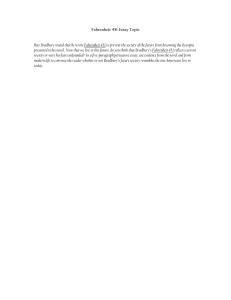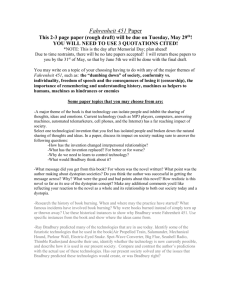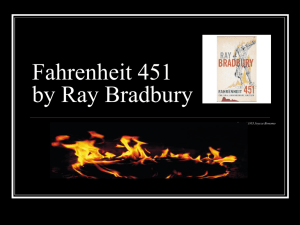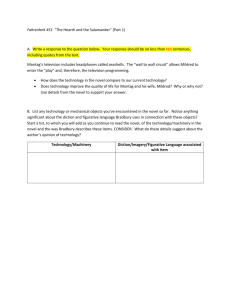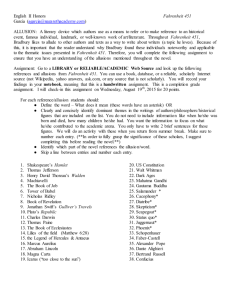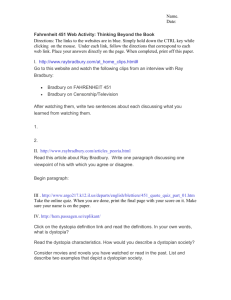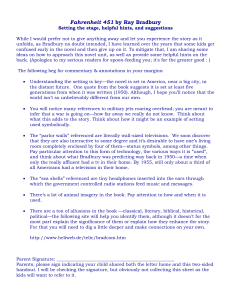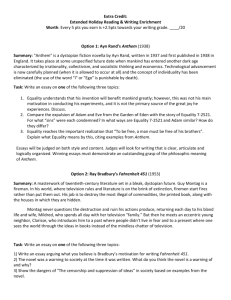Introduction to Fahrenheit 451
advertisement
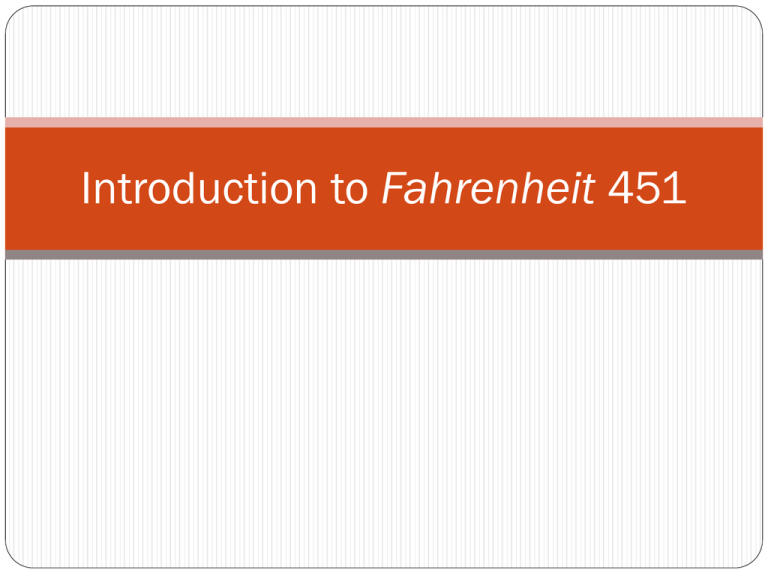
Introduction to Fahrenheit 451 Dystopian Novel A dystopia is a society characterized by a focus on mass poverty, squalor, suffering, or oppression. It is the opposite of utopia (ideal). Dystopian novels show a future that is horrible and degraded due to choices made by mankind. Dystopian novels usually extrapolate elements of contemporary society and are read by many as political warnings. Speculative fiction –speculates on the future based on current society Historical Context Ray Bradbury – an award winning science fiction writer Born August 22, 1920 and died June 5, 2012 The novel began as a short story in 1951 and was finally published in 1953 Reflects many issues from Bradbury’s lifetime Post-World War II era - Fashion, people and society are very conservative. People are generally respectful of each other, the government, religion, and life. Nazi book burnings of the 1930s were widely published after WWII – became a major symbol of the repression in Nazi Germany The novel was written a time when the world was threatened by nuclear war, new technologies were emerging and the world was getting smaller. Impending Danger As the 1950s and the Cold War progressed Ray Bradbury saw the government taking a great deal of power over the people and this worried him. Ray Bradbury saw the world changing quickly and dangerously and this is why he wrote Fahrenheit 451 – to warn people of what would happen if society continued down what he believed was a dangerous path…. The emergence of television Television became dominant medium for mass communication 1946: 7,000 TV sets existed in “The remarkable thing about TV is that it permits several million people to laugh at the same joke and still I feel lonely.” T.S. Eliot the U.S. 1948: 148,000 sets 1950: 4.4 million sets Television vs. books – debate over bringing television into schools because reading level of students was dropping The importance of books and the freedom to read them was a central concern of liberalminded people during the 1950s. Historical Context - McCarthyism Senator Joseph McCarthy made public accusation that Communists had infiltrated the ranks of government, military, literary, and film industries. Helped lead to Cold War and Korean War. Thousands of people lost their jobs as, all across America, state legislatures and school boards mimicked McCarthy and his House on Un-American Activities Committee. Books were even pulled from library shelves, including Robin Hood, which was deemed communist-like for suggesting stealing from the rich to give to the poor. Above all, several messages became crystal clear to the average American: Don’t criticize the United States. Don’t be different. Just conform. By 1953, his accusations were at their height. His hearings were held in 1954 and were the first to be publicly broadcast (ruined his reputation and career). Historical Context - Society Fear of robots and other technology was prevalent in the 1950s (“mad scientist” movies compounded such fear by portraying machines that turned on their creator). Mentality of hard work and following orders to get ahead was prevalent at this time. Atmosphere of fear and repression left over from WWII, development (and use) of atomic bomb, communist scare, the Cold War, and McCarthy made it possible for government or any other powerful group to manipulate public opinion. Movies, books, television shows, people’s opinions, works of art, and other expressions of speech were all censored by the government and other groups. The Setting It is the 24th century. Books are considered dangerous and illegal. Nobody is allowed to own them. Most people are happy being plugged into their technology, where they do not have to think too hard. All books that are found are burned by firemen. Symbols Fire Phoenix The first part of the book Bird from ancient myth is titled “The Earth and the Salamander.” The fire salamander can walk through fire unharmed. Books are burned and ideas are “burned from” the minds of the people. Lives for 500 years and then perches on a nest of spices, singing until sunlight ignites its body and it is engulfed in flame A new phoenix “rises” from the ashes Themes Censorship – books are burned because they trigger discontent and thought. Society – chilling aspect of the novel is the people themselves want the books burned Conformity vs. Individuality Freedom of speech and the consequences of losing it The importance of remembering and understanding history Apathy and Passivity Alienation and Loneliness Change and Transformation Technology -Machines as helpers to humans vs. Machines as hindrances or enemies Bradbury’s view on technology The novel depicts how demanding and oddly isolating technology can be. We have “friends” we have never seen on Facebook, cars with internet access, tablets and smart phones to occupy our time anywhere we go, emails and text messages instead of face-to-face or even voice-to-voice telephone conversations, television instead of books, movies instead of conversation, and we always seem to want more. In the novel, people have abandoned books, conversation, and nature in favor of hollow entertainment and instant gratification. Fast cars, loud music, and a barrage of advertisements create a life of so much stimulation, no one has time for individual thought. Was Bradbury Right? Perhaps the events in Fahrenheit 451 are not too far away. From 1973 until the late 1980s, the FBI conducted a secret surveillance program within America's unclassified scientific libraries, including both public and university libraries. That program, known as the Library Awareness Program, had two goals: To restrict access by foreign nationals, particularly Soviet and East Europeans, to unclassified scientific information; To recruit librarians to report on any "foreigners" using America's unclassified scientific libraries Are we headed for Fahrenheit 451? 60 years after the novel was published: 33% of high school graduates never read another book for the rest of their lives 80% of US families did not buy or read a book last year 57% of new books are not read to completion 42% of college graduates never read another book after college 70% of US adults have not been to a bookstore in the last five years HOWEVER – there are over 17,000 radio stations and over 2,000 TV stations in America today In a 65 year life span, the average person will spend 9 years watching TV The average child sees 20,000 commercials per year The average American child watches over 19 hours of TV per week
